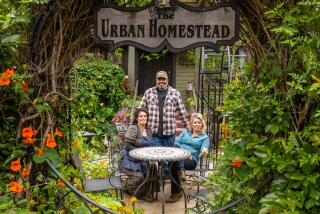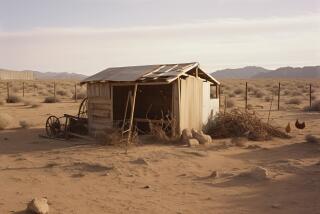The Rise of a ‘Rural Martha Stewart’
- Share via
MOSCOW, Idaho — Rural living is a little different on Mary Jane Butters’ farm.
Hens lay eggs. Workers fill bags of dried soup. Editors prepare the next edition of her magazine. Television producers call.
Butters presides over the bustle, positioning herself to become the new Martha Stewart while the original lifestyles entrepreneur prepares for a January trial on charges of obstruction of justice in connection with the sale of ImClone Systems Inc. stock.
Clarkson Potter, a Random House Inc. branch that also publishes Stewart’s books, will pay Butters $1.3 million for two books that highlight the rural skills and do-it-yourself philosophy she has developed on her organic farm.
The first book, “Mary Jane’s Gathering Place,” is scheduled to be published in spring 2005. The second is tentatively due out in 2006.
The book deal has started a stampede in all things Mary Jane. A newspaper column, which had been appearing in three free weeklies in the Northwest, is being shopped to nationwide syndicators.
Television producers are calling about doing a show. Butters isn’t sure she is interested because of the travel and time required. She made it a condition of her book contract that she not have to do a book tour.
There are even discussions about a line of products -- from peelers to purses -- under the Mary Jane brand.
Butters sees herself as a model for new economic vitality in rural areas and a conduit between rural women who produce goods and shoppers looking to buy those goods.
“I’m going to be an approachable Martha Stewart, a rural Martha Stewart, in my home,” Butters said. “We’re going to resurrect those nearly extinct domestic skills so we are not always buying things produced by a child in Taiwan.”
Her publisher is betting that many Americans are longing for a taste of the comforting skills of pioneer rural women: cooking, gardening, sewing. They see Butters as the nation’s home economics teacher.
“It reminds us of simpler times but acknowledges we live in the present day,” said Pam Krauss, editorial director at Clarkson Potter in New York.
“The most important thing is she is a completely authentic voice,” Krauss said. “It’s not a city dweller’s idea of what it might be like to live on a farm in Idaho.”
“We see a huge potential for Mary Jane the book and Mary Jane the brand,” she said. “We see her as someone we can publish for years to come.”
Krauss declined to compare Butters with Stewart.
“We would rather not draw that comparison,” Krauss said. “She is completely original.”
The book deal grew out of Butters’ self-published magazine, MaryJanesFarm, which in its three issues has offered homespun advice for home and hearth. The magazine also has ordering information for her 60 kinds of dried organic foods, including falafel, hummus, chili and soup.
Born in Ogden, Utah, the 50-year-old has operated her organic farm since 1986.
Butters can barely believe her recent good fortune. Just last winter she was struggling to pay bills while sales of her dried foods plummeted in the slumping economy as the nation prepared for war with Iraq.
She found herself borrowing money from her bookkeeper, her employees took pay cuts and even her banker came through with another loan, she said.
Butters put together a 40-page book proposal, and her agent shopped it around. A bidding war ensued, ending with the $1.3-million deal.
Butters was raised in a large Mormon family in Utah. The family grew, raised or hunted its own food and made its own clothes and other essentials.
In 1976 she joined the U.S. Forest Service and eventually lived in a fire lookout tower.
Knowing she wanted to farm, she spent a decade looking for the right place, envisioning it at the end of a dirt road.
Butters and her two young children were living in Moscow when she saw an advertisement for a five-acre spread a few miles outside the town of 20,000 that sounded perfect.
The farm was owned by two bachelor brothers and lacked amenities such as indoor plumbing. She paid $45,000 for the land on Idaho’s Paradise Ridge and moved in.
“I raised two kids without a toilet here,” she boasted. “No TV and no indoor plumbing.”
Both her children are grown but remain involved in her business, which has expanded from farming to foods.
To fuel growth, she organized a private stock offering in the early 1990s, raising $500,000 from 55 stockholders. She remains majority owner of her company.
Her farm was bordered on three sides by a much larger grain farm owned by Nick Ogle. They have since married.
In her spare time, Butters has been involved in environmental and social justice issues.
The book deal will help her pay off debt and build a new home to replace the original farmhouse, which burned down in 1996.
For now, she sleeps in a bed in her office in the winter. In the summer, Butters has created an outdoor living space under a grove of trees with a bed, dresser, chairs and the other comforts of home.
Her farm produces 60 varieties of garlic, plus iris bulbs and cut flowers and vegetables. It also is the home of her Pay Dirt Farm School, where city people pay to live in rustic cabins and work on her farm for a brief time.
Though their styles differ greatly, Butters admires what Stewart has accomplished for others.
“She gave validity to what women love to do in their homes,” she said. “I’m sorry she is being bashed.”
More to Read
Sign up for our Book Club newsletter
Get the latest news, events and more from the Los Angeles Times Book Club, and help us get L.A. reading and talking.
You may occasionally receive promotional content from the Los Angeles Times.







